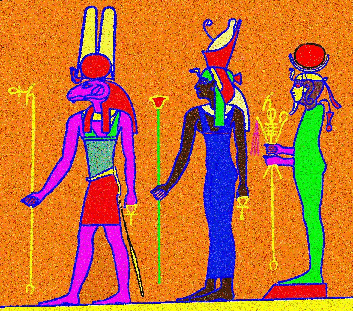
Information concerning the vital contribution of KUSHITE Peoples to world civilization is very obscure. Nubians are hardly ever acknowledged by the celebrated 'scholars' of antiquity. In fact when any reference is made to NUBIA, little or no mention is made of her numerous scientific accomplishmentsNUBIAN GLORY: OUR HERITAGE
It appears that Nubians, somehow lived an isolated, if not deprived existence while the venerated river island of EGYPT ( K'MT/ TA-MERI) flourished. How absurd, when in reality it was a KUSHITE known only as the 'SCORPION' followed by the ruler NARMER ( a.k.a 'Aha-Menes' circa. 2800 B.C.E. ) who were the first to unite the Upper and Lower kingdoms of the Nile. They were preceded by several Pre Dynastic Kushite regents of Lower Egypt, for example: TIU, THESH, HSEKIU, RO, KA & UAZNAR. The existence of these and other personalities have been withheld for too long.
Over the years KUSH/ NUBIA was known by many titles: KASH, TA-SETI, TA- NUHUSI & TA-KENSAT. Her peoples were renown for their hospitality, military prowess, wealth and political diplomacy. They were governed by a hierarchy of KANDAKE ( Warrior Queen Mothers) & ALARA (Warrior Kings) whose reign survived until Circa. 138 C.E..
This incriminating evidence have been in Europeans' possession since the 1800s. However, fortunately or vice versa, an apparent resurgence of the undaunted spirit of Nubians in the Diaspora forced today's self-appointed preservationists to make public alleged 'new' discoveries.
An inevitable exhibition was open to view in late spring 1997 for a pretentious tour of various museums on the European mainland. It constituted a carefully vetted selection of stolen treasures from various international store houses, private collections and universities. The most outstanding of this display was the Ferlini' s stash of jewellery. While other booty included pottery, sculpture and royal figurines ( Ushabti ). While, subject of much discussion was a relief drawing from the Eighteenth Dynasty of NUBIAN warriors, not as slaves but free subjects in service to their matriarchal ruler HATSHEPHUT.
This relic effectively puts lie to a preferred theory of southerners, i.e. KUSHITES / NUBIANS were not included among Royal Blood. When in fact many regents and other prominent personalities of the early dynasties of Egypt were in fact Nubians.
It was Hatshepsut who lead the most celebrated expedition to the empire of PUNT/ PHUT. In early times Egypt / K'MT also enjoyed favourable relations with Phut. But only when Nubians and their Eastern cousins, the BLEMMEYS, a.k.a. BEJA or HADENDOWA ruled the Upper and Lower Kingdoms. The exception being the ancient Libyans. While the hostile attitude of other dynasties in Egypt ( for e.g. Assyrians, Hyksos & Persians ) towards indigenous peoples is well documented.
The Kushite power centres of NAPATA and MEROE served as pivots for trade with the region and their influence stretched even further abroad to the SABÆN and Asian empires. Contact also included the islands and Pre-Columbian Americas beyond the Pacific
It was during the occupation of Egypt by the Roman Empire ( Circa. 1 C.E.) that the visually impaired Nubian Kandake AMANI TARI, recorded as Candace, forced the Romans to sign a peace treaty. This pact permitted vital trade with Kush and Phut in aromatics, precious metals and other goods. Artifacts from across the world were also found in Meroitic ruins.
Modern historians, have always been aware that there is a lot still to be learnt about Kush and her peoples. Europe was effectively cut from Afrika during the period of Islaamic Conquest. This effectively hampered their well known culture of grave robbing. Thus rumours, superstition, romantic folk tales and speculation superceded reality. In fact, their festering greed for precious metals ensured a long standing interest in the region. Pillage was prevalent across the continent during the expansionist period known as Colonialism. This era began soon after the fall of the MAHDI and the disgusting FASHODA incident in European's scramble for Afrika.
The construction of the contentious Aswan Dam also ensured that much evidence of the glory that was Kush has all but disappeared beneath hoarded Nile waters. This does not exclude all that was spirited away under the guise of the infamous 'Save The Nubia Campaign' orchestrated by U.N.E.S.C.O. in the early sixties. Attention should also be drawn to the fact that there are further plans (1998) to construct another dam which would again be disastrous to the remaining heritage.
The current call for REPARATIONS by Afrikans inspired me to offer as evidence just a sampling of what was bequeathed our little ones. May it inspire the youth in their quest for their true heritage as KUSHITES.

GLORY OF KUSH REVEALED
This exhibition is part of an exceptional collection of line drawings and research of Dr. Roi Ankhkara Kwabena Nasara El, who has lived and worked in the Sudan during the late 1980's.
His work seeks to highlight an impressive legacy of KUSH, a little known Afrikan Empire that predated ancient Egypt (K'MT). Located in northern Sudan, it is known by many other names, for example:- Abkan,I-Ram,Nubia,Ta-Nuhusi,Ta-Kensat, Ta-Seti, Kerma, Napata and Meroe.
The existence of Kush is dated earlier than 4,500 B.C.E., before it's decline after being attacked by Christians from Axum (Ethiopia) in 350 C.E. At least seventy-five generations of KANDAKE (queens) & ALARA (kings) survived in Kush long after the occupation of Egypt by the Romans during the Christian Era. Nubian Deities have greatly influenced traditional Afrikan, Asian and Western religious concepts.
Nubians were the first to construct Pyramids & temples; having ruled K'MT for several dynasties. They were renown for their prowess as hunters, fighters and skilled artisans in iron, copper, gold and pottery, they traded with the Far East and Middle Eastern empires; invented their own form of writing (i.e. Hieroglyphs and Meroitic script) and colonised many lands.
There is a lot more to this glorious civilisation that many scientists are willing to admit. These exhibited works form part of the collection of photography/drawings: "Sudan: Then & Now ". It was first open to public view in the Caribbean during 1989. Since then it has been exhibited in Germany, Austria and the United Kingdom ( London, Reading, Dudley, Birmingham, Bristol & Derby ) PostCards and Prints can be ordered. While several Lectures and Panel Discussions from the NEB-MA'AT-RA Series are also available on Audio and in VHS format plus paper-back editions of works published 1994-97.
* Nubian Glory: Our Heritage
Vols.(1) Ta-Meri (2) Ta-Nuhusi
* Nubian Saints of Christianity
* Kush Reclaimed
